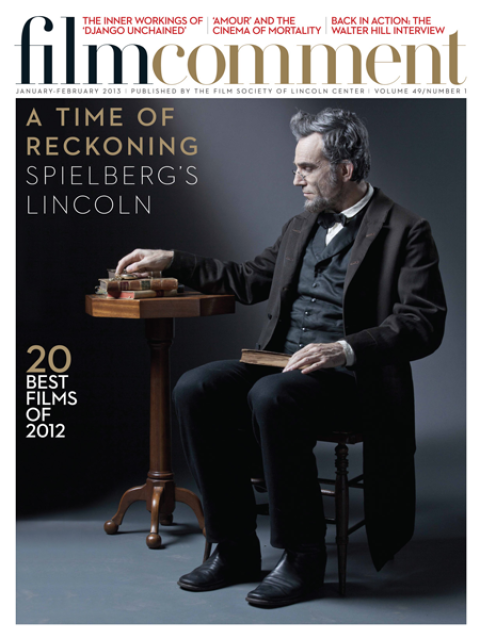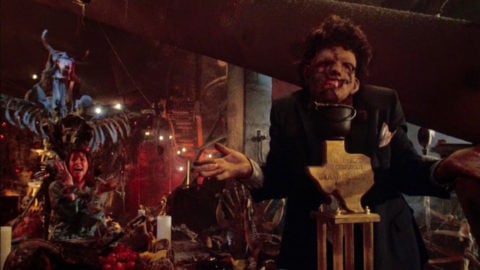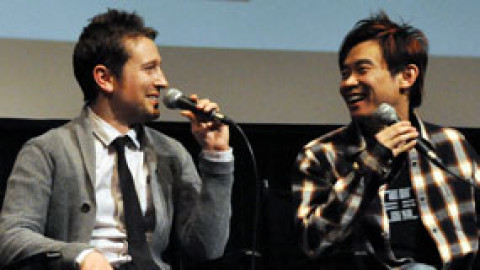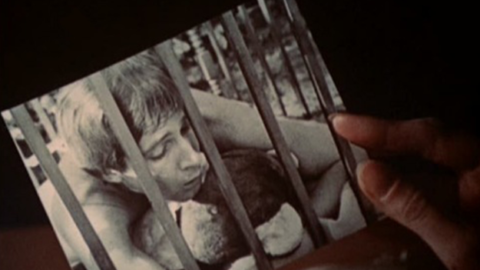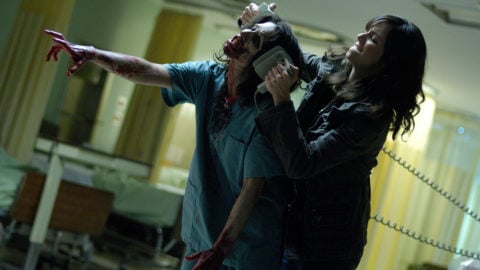

Paranormal Activity 1


Paranormal Activity 2
Whither found-footage horror in 2012? Everywhere, all over the place, alive and kicking and eating people’s tongues. The most gimmicky of contemporary genres doggedly persists despite much jumpage of the shark. (Let us here pass over [REC] 3 in silence.) Nearly a dozen features predicated on found footage were released last year alone, not to mention The River, ABC’s sloppy, ill-fated TV series co-created by Paranormal Activity mastermind Oren Peli. It was not a good year for Mr. Peli—let us here pass over Chernobyl Diaries in silence—or his signature series. Paranormal Activity 4 proved the weakest entry in a cycle that has, film to film, worked variations on a marvelously simple, surprisingly expansive format whose structural elegance marks it as the most lively ongoing experiment in the found-footage aesthetic.
Slated for release this coming October, Paranormal Activity 5 will determine either that the franchise has run out of ideas—fair warning: I’m about to make some serious claims for their existence—or that the fourth entry was a minor stumble. Directed by Henry Joost and Ariel Schulman, the same team behind the excellent third film in the cycle, Paranormal Activity 4 opened to relatively disappointing box office (at least in the multimillion-dollar terms of the franchise) two weeks before the arrival of a superior exercise in faux-archival trauma. A lo-fi eco-thriller directed by Barry Levinson, The Bay chronicles the exceptionally nasty outbreak of a mutant flesh-eating parasite during a July 4th celebration in a Chesapeake Bay resort town. Presented in the form of an improbably eclectic reportage assembled after the fact by a neophyte journalist (Kristen Connolly) who has witnessed, and now narrates, the day’s events, The Bay is hobbled by a feckless characterization straining to serve double duty as controlling point of view and audience surrogate. However, this structural weakness doesn’t undermine the experience of the movie, since structure itself is what we’re made to engage with in much of the found-footage horror genre. Acting is entirely beside the point in The Bay; the movie’s palpable investment is in the ensemble performance of its various media platforms. Levinson, with quite a lot of help from editor Aaron Yanes, leaps capriciously through a sprawl of image sources: home video, newscasts, guerrilla reporting, security cameras, video diaries, iPhone FaceTime, police car cameras, conference calls, scientific documentation, online video, audio files, etc.
This crazy-quilt method—call it rhizomatic montage—characterizes a minor subset of the found-footage horror film, more often dominated by single-camera image streams, as in [REC] (07) and Cloverfield (08), or the dictates of a fictitious production, traditionally the making of a movie, as in The Blair Witch Project (99). George Romero wittily conflated the two modes in Diary of the Dead (07), a multi-platform narrative that incorporated the shooting of a zombie flick entitled The Death of Death by a group of hapless film students. Had they survived the apocalypse and acquired some postgrad competencies, those same students might have gone on to make V/H/S (12), an omnibus feature directed by five young filmmakers in addition to a four-member collective known as Radio Silence. The individual narratives in V/H/S—pseudo-feminist vampiric reprisals, oracular lesbian murder plots, sub-Cronenbergian reproductive shenanigans, spooky shit in the woods, spooky shit in houses, spooky shit in cars—are unified by the predominance of douchebag protagonists and framed by a meta-narrative involving a cache of VHS tapes discovered in a derelict house.

Sinister
The role of analogue media in the genre is put to better use in Sinister, the creepiest of 2012’s found-footage frighteners. There’s a distinction to be made here: in Sinister, as in Cannibal Holocaust (80) and 8MM (99), found footage operates as a distinct artifact within the narrative rather than as an overall narrative delivery vehicle. (Although, as we’ll see, the Paranormal Activity series blurs this distinction.) Ellison (Ethan Hawke), an ambitious writer of true crime books, transplants his family to a small town—without bothering to mention that their new house is the object of his latest opus, having been the site of an unsolved backyard murder-by-hanging of four. He soon discovers a box of 8mm reels in the attic documenting a number of serial murders, the projection of which widens the scope of his research and, (un)naturally, reactivates dormant bad mojo. Ellison’s manipulation of this material (projecting, re-photographing, digitizing, editing, analyzing, screen-grabbing), and the way the material manipulates itself (disappearing, reappearing, altering, self-projecting) points to the genre’s tendency to collapse metaphysics and epistemology. As often as the footage comprising these films presents itself as testimony of the inexplicable (“The world needs to know what happened!”), it also deploys a feedback structure in which the characters not only record their experiences but also analyze those recordings (“What is happening to us?”). “Once we get it on camera we can know what’s going on,” claims a video enthusiast in Paranormal Activity, “and once we know what’s going on we can act appropriately.” (Appropriate action in this case means hanging around and shooting more footage until you’re stabbed to death by a demonically possessed spouse.)
A trope of the found-footage genre is to open with a title card specifying some governmental institution serving as a repository for the materials we’re about to see. Each of the Paranormal Activity films, for example, comes courtesy of local police departments (Carlsbad, San Diego), who would appear to have a team of in-house editors shaping the raw footage for maximum dramatic impact and a collective eye toward the placement of clues to the overarching mythology of the series.
So far as I can parse it—and my research, I confess, has not ventured into the depths of online geek exegeses—the Paranormal Activity master narrative goes more or less like this: a demonic entity, as yet unseen after four installments, has either been summoned by, or is in some form of alliance with, a coven of witches with designs on two sisters, Katie (Katie Featherston) and Kristi (Sprague Grayden). The two women are not the direct focus of the demonic project but rather are being monitored and manipulated to deliver over their first-born son between them, for reasons as yet unspecified. Set in 1988, 18 years before the events of the first two films, Paranormal Activity 3 clarifies the degree to which these malignant forces have been fucking with the girls throughout their lives. Once we understand how thoroughly, and for how long, they’ve been tormented by a demonic conspiracy, the violent extremity of what befalls the sisters in the third film retroactively charges their behavior in the first two with an extraordinary degree of repression.

Paranormal Activity 3
This master narrative has been carefully parceled out across the cycle, but it is largely beside the point. The Paranormal Activity movies are much less interested in offering pieces of a puzzle for us to assemble than in demanding our absolute attention to the specific, immediate unfolding of events in any given shot. The ruling pleasure of these movies lies in the rigor with which they invite us to scrutinize their images, the meticulous care with which said images have been booby-trapped for surprise, and the shrewd deployment of duration and repetition toward these ends. Paranormal protagonists capture images in all kinds of ways, but each movie features its signature Automated Tableau: a fixed-position viewpoint on a domestic interior that’s offered up for us to inspect for either super-subtle fluctuations (faint shadowy movements), medium-scale events (the opening and closing of doors), or hardcore shocks (exploding kitchens, people being dragged down hallways). In the first movie, the Automated Tableau is a shot of a couple’s bedroom dominated by a king-sized bed with a hallway to the left that serves as the main entry/exit point for freaky business. The second film, keyed to a half-dozen security cameras installed in a capacious Southern California home, significantly multiplies both the number of Tableaux and their potential zones of action: a nursery with two doorways, a mirrored closet, and a window; a kitchen with five potential vectors of activity; a magnificently complex living room scene that reverses the kitchen perspective while adding visual passageways to the foyer, patio, and basement; a hallway shot serving as a kind of nexus for inside/outside and upstairs/downstairs proceedings; and, hilariously, a camera trained on the backyard, where the demonic presence evidently delights in making the swimming pool’s automated vacuum-bot do weird shit. The second film’s major expansion of the Automated Tableau’s zones of action, passageways of potentiality, and points of interest is used to great effect. Even more than its predecessor, Paranormal Activity 2 involves the spectator in an uncommon focus of attention on every crevice and corner of the frame, tensed to both the subtlest modulation and the imminent whammo!. If Jacques Tati went slumming in the found-footage horror genre, he could scarcely improve on the design of these Automated Tableaux.
Paranormal Activity 3’s most engaging Tableau is motorized: a camera attached to a rotating fan that allows for a steady pan shot from kitchen to living room and back. Dennis (Chris Smith), who jury-rigs this gizmo, makes his living as a wedding videographer; why this footage is wide-screen, while everything he examines in his garage editing suite has been shot in the standard 4:3 aspect ratio of the late Eighties, goes unexplained. But no matter: the panning shot sets up the franchise’s cleverest automation and one of its single best scenes, the shock-gag of a Halloween-costume-style ghost-in-a-sheet that actually is a ghost in a sheet. This mechanized mise en scène device is the cycle’s supreme achievement in the generation of suspense through pacing—and patience. Contrary to the frantic handheld agitations characteristic of contemporary horror, both found-footage and garden variety, the Paranormal Activity films are devoted to the slow-burning accumulation of potential frights rather than abrupt assaults. Although they’re pretty good at those too.

Paranormal Activity 4
Much of the disappointment of Paranormal Activity 4 results from a lackluster handling of webcams, video chat, and Microsoft’s Kinect, a game console that sends out a field of little green dots to enable its motion capture function. Kinect produces some beautiful, terrifically mysterious images of a living room awash in a pinpoint matrix, and some very dull intimations of things creeping around within it. Nowhere does the fourth film generate the Tableau tension of the second, al-though it repeats many of the earlier film’s setups (living room, kitchen) and its prop-based weirdness: a bit of business with a possessed carving knife marks the nadir of the series’s kitchen-set shocks.
Will the next installment be titled Paranormal Interactivity? The fourth film underlines, without delivering on, a persistent theme of the cycle: the very act of documenting the activity appears to further motivate it. Moreover, there’s a sense in which the “activity” wants to be recorded. In the first Paranormal Activity, Katie repeatedly tells Micah that attempting to film what’s happening while they sleep will only make matters worse, and is infuriated when he summons whatever forces are at work—and indeed exacerbates the situation—with a Ouija board. An alternate version of the climax available on the DVD ends with Katie, covered in Micah’s blood, approaching the bedroom camera and slitting her own throat while staring directly into the lens. Who is being appeased here, the audience of the film or some satanic auteur? The security cameras of Paranormal Activity 2 are installed in the aftermath of a break-in and ransacking of the family home, but the only thing missing is a necklace given to Katie by her sister. Hewing to the mythology, we might credit the invasion to a clumsy demon overturning cushions to retrieve this talisman, but in the terms of the cycle’s own logic this could also be understood as the demon’s incessant desire to be observed: it was hoping they’d install the cameras. “The more we paid attention to it,” remembers Katie of her childhood ordeal, “the worse it got.” Paranormal Activity 3 offers the definitive formulation: “When are you gonna stop taping this?” “Not until this thing’s over.”



